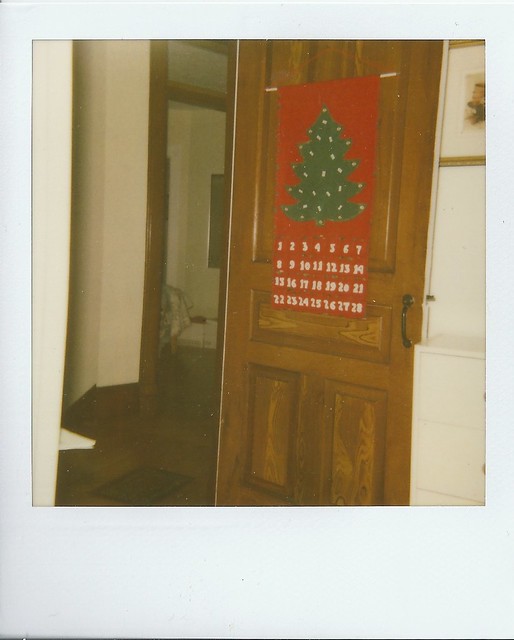Hello Polaroiders, it’s been too long! So, let’s jump right into this instalment of In Search of the Perfect Polaroid!
Well, seeing as it’s Halloween, I thought I’d use a picture taken last… Christmas:
Look closely at the picture; what’s special about it? Okay, a lot’s special about it, because every Polaroid is special. Like snowflakes. Hmm. There is an all too cliche but still maybe beautiful blog post in there. We’ll see. Anyway, look at the walls in the picture. How many do you see? Well, there are actually quite a few since it’s a very angular house, but there are three main ones. Layers. You see them? First, the wall with the door against it, that features the Felt Christmas Tree Calendar of Impatience. Got it? Good. Second, the wall that is attached to the main brown doorframe; from the left, it’s about a quarter of the way into the picture. Alright, ready for the third one? Squint, peak across the hallway and into the other room. See those boxes, underneath a mirror? These items are against the third wall. So! What does this mean? Well, think about it. Those three walls, what was the difference between them? Yes…? We moved further back into the house, and therefore into the picture, as we went from 1 to 3! So. That might have seen like a really drawn out exercise to pick out walls, but I think this picture is a really good demonstration of, you guessed it, foreground, mid-ground, and background!
That brings us to Today’s Tip: establish clear layers of a scene. Polaroids, we love them, but they are sometimes a little blurry and difficult to understand. Now, that fuzzy-factor is often what makes a Polaroid so cool, but you know, you want to be able to see something going on. Establishing a foreground, mid-ground and background does just this: clarifies the zones within your photo, making it easier to decipher the scene as a whole. So, when you’re setting up your picture, make sure you’ve got at least two layers to add this depth that I’m talking about, and chances are, one of these layers will turn out okay. Because you never know with Polaroids, they can be a little moody. (I get it though, I’ve been there.)
Now, go establish some foregrounds and backgrounds and mid-grounds and side grounds or really no grounds at all if you want to go super abstract, because those photos can turn out pretty unreal too, but at least always be aware of the depth in your photo. It’s likely that there are layers, even if your subject is really close-up; understanding where these layers are helps to find new details within the picture as a whole.
Happy Halloween and Merry Christmas!:) And good luck snapping your layered Polaroids!
RJ
